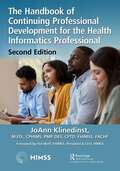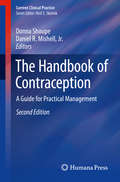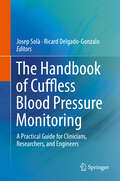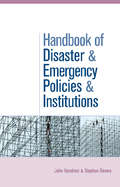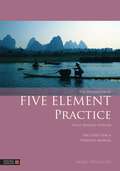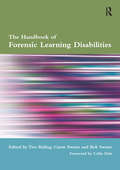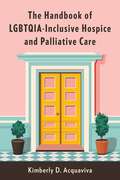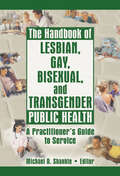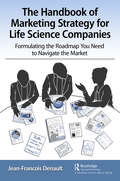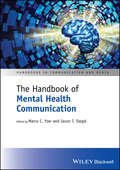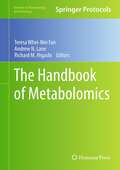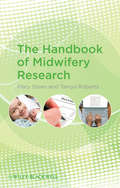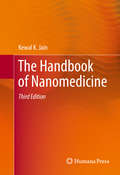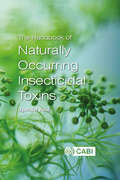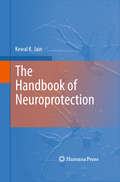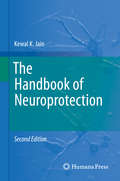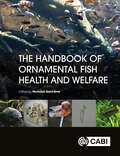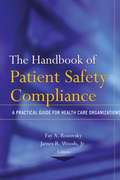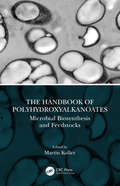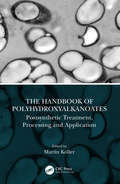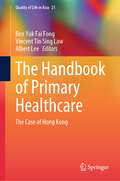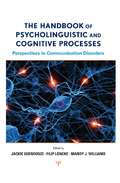- Table View
- List View
The Handbook of Continuing Professional Development for the Health Informatics Professional (HIMSS Book Series)
by JoAnn KlinedinstEngaging in ongoing, continuing professional development (CPD) is a strategic imperative for the health informatics professional. In our global economy, healthcare is fast-paced, dynamic, and ever-changing. While this rapid change is both exciting and exhausting, digital health transformation is positively impacting lives, today and every day, in ways not previously imagined. Faced with a COVID-19 pandemic that has forever changed the landscape of health and care delivery, global health and care stakeholders must ensure that our ecosystem continues to rapidly evolve through innovation, government and ministry incentives, and technological advancements to reach citizens everywhere. For these reasons, health informaticists must embrace lifelong learning to ensure they have the professional competencies to advance initiatives that positively impact patient care. The Handbook of Continuing Professional Development for the Health Informatics Professional, Second Edition has adapted to the evolving needs of health and care professionals everywhere. The Handbook provides the rationale and the resources to do so and serves as a reference to enhance one’s career. No other comprehensive resource exists to assist health informaticists in developing and maintaining their professional competencies. Written as a contributed compilation of topics by leading practitioners, the book discusses the most critical competencies needed to ensure understanding of the vast health and care ecosystem while also highlighting industry influences that shape the very evolution of health information and technology. About HIMSS The Healthcare Information and Management Systems Society (HIMSS) is a global advisor, thought leader, and member association committed to transforming the health ecosystem. As a mission-driven non-profit, HIMSS offers a unique depth and breadth of expertise in health innovation, public policy, workforce development, research, and analytics to advise leaders, stakeholders, and influencers from across the ecosystem on best practices. With a community-centric approach, our innovation engine delivers key insights, education, and engaging events to healthcare providers, payers, governments, startups, life sciences, and other health services organizations, ensuring they have the right information at the point of decision. HIMSS has served the global health community for more than 60 years with focused operations across North America, Europe, the United Kingdom, the Middle East, and Asia-Pacific.
The Handbook of Contraception
by Jr. Donna Shoupe Daniel R. MishellThis book presents an up-to-date and comprehensive review of female contraception. It offers an extensive overview of contraception types, including oral, injectable, emergency, and various cervical barrier contraceptives, as well as behavioral and sterilization methods, and discusses the clinical effectiveness, advantages, disadvantages, side effects, and mechanisms of action of each method. Thoroughly revised and updated, the second edition includes coverage of chewable contraceptives, new progestins, new quadraphasic OCP regimen, Nexplanon, which is replacing the Implanon contraceptive implant, and new methods of tubal sterilization. There is also a new chapter devoted to current controversies. Each chapter also includes counseling tips that answer common questions many clinicians and patients have about contraception. The advances in contraception technologies are interplayed with practical advice on choosing the most effective and appropriate contraception for patients, from those who are young and healthy to those with serious medical diseases. The Handbook of Contraception, Second Edition, is an incomparable reference for obstetricians, gynecologists, and primary care physicians.
The Handbook of Contraception: Evidence Based Practice Recommendations and Rationales (Current Clinical Practice)
by Donna ShoupeThis book presents an up-to-date and comprehensive review of female contraception, offering an extensive overview of contraception types, including oral, injectable, emergency, and various cervical barrier contraceptives. It also discusses behavioral and sterilization methods of contraception as well as the clinical effectiveness, advantages, disadvantages, side effects, and mechanisms of action of each method.Now in its fully revised and expanded third edition, this text includes seven new chapters that address specific clinical issues that healthcare providers face daily. These issues include patients with medical problems, perimenopausal women, the adolescent population, post-pregnancy patients, patients with bleeding problems, fibroids or hyperplasia, obese patients and patients with acne or hirutism. There is also a new chapter dedicated to contraceptive methods that are currently in development. Each chapter reviews the correct use of the individual method, the most appropriate candidates, timing of initiation, red flag contraindications, risks and benefits, method of action, handling side effects, non-contraceptive benefits, switching methods and the CDC Medical Eligibility for the method. Importantly however, there is a new emphasis placed on standardized evidence-based practice recommendations incorporating the most recent US Selected Practice Recommendations and rationale as published by the US CDC. Written by experts in the field, The Handbook of Contraception, Third Edition, is a valuable resource for obstetricians, gynecologists, reproductive medicine specialists and primary care physicians.
The Handbook of Cuffless Blood Pressure Monitoring: A Practical Guide for Clinicians, Researchers, and Engineers
by Josep Solà Ricard Delgado-GonzaloThis book is the first comprehensive overview of the emerging field of cuffless blood pressure monitoring. Increasing clinical evidence proves that longitudinal measurements of blood pressure allow for earlier detection and better management of multiple medical conditions and for superior prediction of cardiovascular events. Unfortunately, today’s clinical and industry standards for blood pressure monitoring still require the inflation of a pneumatic cuff around a limb each time a measurement is taken. Over the last decades clinicians, scientists and device manufacturers have explored the feasibility of technologies that reduce or even completely eliminate the need of cuffs, initiating the era of cuffless blood pressure monitoring. Among the existing literature, this book is intended to be a practical guide to navigate across this emerging field. The chapters of the handbook have been elaborated by experts and key opinion leaders in the domain, and will guide the reader along the clinical, scientific, technical, and regulatory aspects of cuffless blood pressure monitoring.
The Handbook of DOHaD and Society: Past, Present, and Future Directions of Biosocial Collaboration
by Jaya Keaney Michelle Pentecost Tessa Moll Michael PenklerResearch in the field of Developmental Origins of Health and Disease has had a fundamental impact on our understanding of how environmental experiences and contexts influence the development of health and disease over the entire lifecourse. Covering a wide range of geographic regions, this volume includes an overview of the field, key concepts, and cutting-edge examples of interdisciplinary collaboration. The first reference text covering the interdisciplinary work of DOHaD, a broad list of contents maps the history of DOHaD, showcases examples of biosocial collaboration in action, offers a conceptual toolkit for interdisciplinary research, and maps future directions for the field. The definitive volume on biosocial collaborations in DOHaD, this will be indispensable for scholars working at the intersections of public health, lifecourse epidemiology and the social science of DOHaD. This title is also available as Open Access on Cambridge Core.
The Handbook of Disaster and Emergency Policies and Institutions
by Stephen Dovers John HandmerDisasters both natural and human-induced are leading to spiralling costs in terms of human lives, lost livelihoods and damaged assets and businesses. Yet these consequences and the financial and human crises that follow catastrophes can often be traced to policies unsuited to the emerging scales of the problems they confront, and the lack of institutional capacity to implement planning and prevention or to manage disasters. This book seeks to overcome this mismatch and to guide development of a policy and institutional framework. For the first time it brings together into a coherent framework the insights of public policy, institutional design and emergency and disaster management.
The Handbook of Five Element Practice
by Nora FranglenA practical companion for students and practitioners of five element acupuncture that helps stimulate thoughts, refresh memories and strengthen the foundation of practice. With detailed outlines of the different components of five element diagnosis and treatment and overviews of the main characteristics of the five elements, this complete manual will support and invigorate practice. Full of examples, it explores the skills and techniques needed to nurture patient-practitioner relationships, assess patients correctly, select appropriate treatments and needle the points effectively. The book also includes a Teach Yourself Manual to further refresh understanding of this ancient form of healing. This comprehensive handbook will be of immeasurable use to students and practitioners of five element acupuncture, as well as those who are interested in studying acupuncture and want to know more.
The Handbook of Forensic Learning Disabilities
by Bob Swann Tim Riding Caron SwannThis comprehensive and practical guide helps professionals and staff within hospitals change the way they collect record store and use clinical information about patients. It illustrates how clinical governance and evidence-based practice can be easily addressed by modernising clinical information practice to benefit patients and improve staff and service efficiency. As well as helping organisations define and establish improved systems this book is of continuing use for all healthcare professionals who make store and use patient records. 'High quality shared record keeping is recognised as being fundamentally important to good patient care. This book offers an excellent practical approach to addressing the changes needed in clinical record keeping to support improved patient care clinical governance better management information and the move towards electronic patient records. It brings together a strong clinical focus with the informatics principles needed to support a successful move to modern record keeping.' Yvonne Baker and Tricia Woodhead in the Foreword It will be a useful guide for clinicians and all other health professionals dealing with clinical information.
The Handbook of Jungian Play Therapy with Children and Adolescents
by Eric J. GreenDemystifying Jungian play therapy for non-Jungian therapists interested in enhancing their clinical repertoire.Child and family psychotherapist Eric J. Green draws on years of clinical experience to explain his original model of Jungian play therapy. The empathic techniques he illuminates in The Handbook of Jungian Play Therapy with Children and Adolescents can effectively treat children who are traumatized by abuse, natural disasters, and other losses, as well as children who have attention deficit and autism spectrum disorders. The overarching goal of Green’s Jungian play therapy model is to help children and adolescents become psychologically whole individuals. Toward that end, therapists encourage children to engage in sandplay, spontaneous drawing, and other expressive arts. Green demonstrates how therapists can create an atmosphere of warmth and psychological safety by observing the child’s play without judgment and, through the therapeutic relationship, help children learn to regulate their impulses and regain emotional equilibrium.Designed for master’s level and doctoral students, as well as school counselors, play therapists, and private practitioners, the book covers the theoretical underpinnings of "depth psychology" while highlighting easy-to-understand case studies from Green’s own practice to illustrate Jungian play therapy applications at work.
The Handbook of LGBTQIA-Inclusive Hospice and Palliative Care
by Kimberly D. AcquavivaHospice and palliative care professionals are experts at caring for individuals and families experiencing serious or life-limiting illnesses. Not everyone feels safe seeking out their expertise, however: LGBTQIA+ people may be deterred from seeking support because of barriers—both overt and subtle—that hospice and palliative care programs and professionals erect through their policies and practices. This book is an accessible, expert guide to incorporating LGBTQIA-inclusive practices into end-of-life care. It equips both new and experienced hospice and palliative care professionals with the knowledge they need to ensure that all people receive high-quality care.Kimberly D. Acquaviva surveys fundamental concepts and the latest clinical developments, integrating relatable anecdotes and poignant personal reflections. She discusses her own experience caring for her wife, Kathy, who was diagnosed with ovarian cancer in 2019. Unable to find a local hospice with an LGBTQIA-inclusive nondiscrimination statement, let alone one whose staff had been trained to provide nondiscriminatory care to LGBTQIA+ people, Kathy died at home six months later without hospice care.Acquaviva offers clear, actionable strategies for palliative care and hospice physicians, physician associates, advanced-practice registered nurses, registered nurses, social workers, counselors, chaplains, and others. She also emphasizes how incorporating LGBTQIA-inclusive practices can transform work with every person receiving care. Anchored in the evidence and written in plain language, this book is the definitive guide for hospice and palliative care professionals seeking to deliver exceptional care to all the patients and families they serve.
The Handbook of Lesbian, Gay, Bisexual, and Transgender Public Health: A Practitioner's Guide to Service
by Michael ShankleGet the comprehensive resource for LGBT public health issues!Public health services for sexual minorities have suffered from practitioners&’ lack of knowledge about sexual or gender orientation, specific health concerns, and inherent system homophobia and heterosexism. The Handbook of Lesbian, Gay, Bisexual, and Transgender Public Health: A Practitioner&’s Guide to Service provides a unique focus on LGBT public health, offering positive direction for practitioners looking for guidance in methods to ensure a healthy community for all while taking into consideration the special needs of sexual minorities. Ignorance and fear by both practitioners and LGBT clients leads to less-than-optimum public health services. The Handbook of Lesbian, Gay, Bisexual, and Transgender Public Health extensively discusses these issues clearly, working to foster cultural competency among public health professionals. This book lays the groundwork for better understanding of LGBT health issues and their relationship to overall public health, then delves into the research on how incorporating LGBT cultural competency can improve academic institutions and continuing education programs. The problem of providing health care access and the health issues burdening each segment of the LGBT community are discussed in detail, all with a focus on providing effective solutions to tough challenges. Clear strategies are also presented for improving city, county, state, and national public health infrastructures and policies. The issue of productive and safe work environments in business and the private sector for LGBT individuals is addressed, along with a close look at the advantages-and pitfalls-of media and Internet resources. Many chapters are illustrated with tables and diagrams; each chapter is exhaustively referenced, includes useful lists of selected resources, and asks questions to spark thought on the issues as they pertain to the reader's circumstances. The Handbook of Lesbian, Gay, Bisexual, and Transgender Public Health discusses: the inequities in health care for LGBT people overt prejudice, discrimination, disdain, or outright denial of services assumption by health professionals of risk factors based on sexual or gender orientation rather than individual behaviors and health history unwitting expression of biases of many public health practitioners the effect of social stigma on public health care services LGBT cultural competency framework for institutions of higher learning and professional organizations LGBT awareness, sensitivity, and competency training sexually transmitted diseases reproductive cancers intimate partner violence noncommunicable diseases among gay and bisexual men &’down low&’ behavior (avowed straight men with spouses having sex with other men) as public health issue AIDS-related malignancies transsexuals and transphobia hormonal therapy sex reassignment surgery (SRS) mental health needs of transsexuals, cross-dressers, and intersex individuals barriers to health care access insurance systems confidentiality of medical records substance use health care issues for LGBT youth and young adults health care needs of LGBT elders recommendations for improvement of health and welfare servicesThe Handbook of Lesbian, Gay, Bisexual, and Transgender Public Health is a one-of-a-kind resource for LGBT public health issues, essential for public health professionals, practitioners, health services professionals, substance abuse counselors, disease intervention specialists, public health advisors, community health service administrators, community based agencies, and community health nurses. Educators in community hea
The Handbook of Marketing Strategy for Life Science Companies: Formulating the Roadmap You Need to Navigate the Market
by Jean-Francois DenaultThe proposed book is follows in the same steps as the first book in the series, The Handbook of Market Research for Life Sciences. While the first book focused on the techniques and methodologies to collect the market data you need to evaluate your market as well as presentation models for your data, the second volume will focus more on the commercialization elements of marketing. As such, this book will be covering a wide range of topics directly tied to marketing management such as marketing and commercialization strategies, consumers’ behaviors, marketing metrics, pricing techniques and strategies as well as marketing communications (public relations, advertising, and more). The objective of this book is to focus exclusively on the marketing aspects for life sciences, providing entrepreneurs with a toolkit of tools they can use throughout the marketing process, from market planning to commercialization. The overall objective is for them to gain an understanding on the marketing function, ask the right question, and be able to tackle simple to complex topics.
The Handbook of Mental Health Communication
by Jason T. Siegel Marco C. YzerThe first book of its kind to offer a transdisciplinary exploration of mass communication approaches to mental health In the Handbook of Mental Health Communication, a panel of leading scholars from multiple disciplines presents a comprehensive overview of theory and research at the intersection of mass communication and mental health. With timely and authoritative coverage of the impact of message-based mental health promotion, this unique volume places mental health communication in the context of socio-cultural causes of mental illness — synthesizing public health, psychopathology, and mass communication scholarship into a single volume. Throughout the Handbook, nearly one hundred contributing authors emphasize that understanding communication effects on mental health outcomes begins with recognizing how people across the spectrum of mental illness process relevant information about their own mental health. Fully integrated chapters collectively translate biased information attention, interpretation, and memory in mental health illness to real-world implications of mental illness symptomatology and across the spectrum of mental health issues and disorders. Providing a clear, evidence-based picture of what mental health promotion should look like, The Handbook of Mental Health Communication is an invaluable resource for advanced undergraduate and graduate students, scholars, researchers, lecturers, and all health communication practitioners.
The Handbook of Metabolomics
by Richard M. Higashi Teresa Whei-Mei Fan Andrew N. LaneVital to academic researchers, the medical field, and especially to biotech and pharmaceutical scientists, metabolomics is a rapidly expanding field that will provide a key link between functional biology (phenotypes) and the inner workings of cells in tissues or whole organisms. In The Handbook of Metabolomics, expert researchers provide readers with the current state of metabolomic development and the integration of metabolomics with transcriptomics and proteomics, illustrated by research efforts related to toxicology and pharmacology. The detailed contributions deal with topics ranging from sample preparation and considerations, both laboratory and clinical, analytical methodologies for metabolite and isotopomer profiling, metabolic flux modeling, database construction, and the integration of 'omics for systems biochemical understanding, amongst other topics. Thorough and authoritative, The Handbook of Metabolomics serves as an ideal reference for all those who wish to further pursue this promising area of study.
The Handbook of Midwifery Research
by Mary Steen Taniya RobertsResearch is a fundamental part of midwifery practice. However, not everyone finds it easy to understand the basic principles, and particularly the language of research. This accessible handbook enables midwives and student midwives to firstly understand how to search and make sense of research evidence, how to write a research proposal and finally how to undertake a research study.The Handbook of Midwifery Research specifically focuses on the needs of midwives and students and helps increase the knowledge and understanding of midwifery research, enabling the reader to undertake research with confidence. With case studies, learning objectives and clear examples throughout, this is an essential purchase for any midwife or student wanting to understand or undertake research. This handbook includes useful tools and techniques to assist midwives and students to keep themselves up-to-date with the best available evidence, enabling them to apply this evidence to their own clinical practice.An essential resource for midwifery students as well as qualified midwivesClear, straightforward, and accessible in styleProvides midwives and students with the skills to undertake research with confidenceProvides examples throughout to apply research to midwifery practiceIncludes a glossary of research terms
The Handbook of Nanomedicine
by Kewal K. JainNanomedicine is clinical medicine with the application of nanobiotechnology, which is currently being used to research the pathomechanism of disease, refine molecular diagnostics, and aid in the discovery, development and delivery of drugs. In The Handbook of Nanomedicine, Prof. Kewal K. Jain distills the voluminous literature relevant to the subject into one concise, comprehensive and easy-to-use guide. Beginning with the basics, the subject is developed to potential clinical applications, many of which are still at an experimental stage. Important components of nanomedicine such as nanodiagnostics and nanopharmaceuticals are covered extensively. As this text is aimed at nonmedical scientists, pharmaceutical personnel, as well as physicians, descriptions of the technology involved and other medical terminology are kept as clear and simple as possible. In depth and cutting-edge, The Handbook of Nanomedicine informs its readers of the ever-growing field of nanomedicine, destined to play a significant role in the future of healthcare.
The Handbook of Naturally Occurring Insecticidal Toxins
by Opender KoulNaturally occurring toxins are among the most complicated and lethal in existence. Plant species, microorganisms and marine flora and fauna produce hundreds of toxic compounds for defense and to promote their chances of survival, and these can be isolated and appropriated for our own use. Many of these toxins have yet to be thoroughly described, despite being studied for years. Focusing on the natural toxins that are purely toxic to insects, this book contains over 500 chemical structures. It discusses the concepts and mechanisms involved in toxicity, bioassay procedures for evaluation, structure-activity relationships, and the potential for future commercialization of these compounds. A comprehensive review of the subject, this book forms an important source of information for researchers and students of crop protection, pest control, phytochemistry and those dealing in insect-plant interactions.
The Handbook of Neuroprotection
by Kewal K. JainNeuroprotection has been placed on a firm scientific basis during the past decade due to an improved understanding of the molecular basis of neurological diseases and the knowledge that treatment of neurological disorders should not be merely symptomatic but preventative against the progression of the underlying disease, as well as regenerative. The Handbook of Neuroprotection serves as a comprehensive review of neuroprotection based on knowledge of the molecular basis of neurological disorders. Neuroprotective effects of older, established drugs, as well as new drugs in development, are well documented in this detailed volume, featuring the most cutting-edge and innovative methods currently in use. In-depth and authoritative, The Handbook of Neuroprotection features a compendium of vital knowledge aimed at providing researchers with an essential reference for this key neurological area of study.
The Handbook of Neuroprotection
by Kewal K. JainThis fully revised edition explores the management of neurological disorders with a focus on neuroprotection, disease modification, and neuroregeneration rather than symptomatic treatment. Since the publication of the first edition, advances in biotechnology, particularly in cell and gene therapies, are reflected in this volume, as are numerous new and repurposed drugs in clinical trials. Overall, The Handbook of Neuroprotection serves as a comprehensive review of neuroprotection based on knowledge of the molecular basis of disorders of the central nervous system. In-depth and authoritative, The Handbook of Neuroprotection, Second Edition features a compendium of vital knowledge aimed at providing researchers with an essential reference for this key neurological area of study.
The Handbook of Ornamental Fish Health and Welfare
by Nicholas Saint-ErneThis book forms a complete resource covering ornamental fish health and welfare from a recognized expert on the topic. Beginning with an overview of the tropical fish industry and aquarium keeping, it covers all the key elements of care, including water-quality testing and maintenance, filtration systems, nutrition, husbandry, handling and transportation of fish, disease diagnosis, treatments and medications, and disease prevention. It also reviews areas of wider interest, such as biosecurity and zoonoses. The book can be read through to gain a complete overview of the care and welfare of ornamental aquarium and pond fish, or it can be used to easily look up specific information about a topic of interest. With numerous illustrations and photographs, plus references allowing readers to study areas of interest in more detail, this book makes an invaluable teaching and reference handbook. It is a vital source of information for veterinarians, scientists using fish in their labs, students, ornamental fish breeders, retail pet store workers, and aquarium keepers looking for trusted advice about how to properly care for their ornamental freshwater fish.
The Handbook of Patient Safety Compliance: A Practical Guide for Health Care Organizations
by Fay A. Rozovsky James R. Woods Jr. Maree BellamyWritten for virtually every professional and leader in the health care field, as well as students who are preparing for careers in health services delivery, this book presents a framework for developing a patient safety program, shows how best to examine events that do occur, and reveals how to ensure that appropriate corrective and preventative actions are reviewed for effectiveness.
The Handbook of Polyhydroxyalkanoates: Microbial Biosynthesis and Feedstocks
by Martin KollerThe first volume of the "Handbook of Polyhydroxyalkanoates (PHA): Microbial Biosynthesis and Feedstocks" focusses on feedstock aspects, enzymology, metabolism and genetic engineering of PHA biosynthesis. It addresses better understanding the mechanisms of PHA biosynthesis in scientific terms and profiting from this understanding in order to enhance PHA biosynthesis in bio-technological terms and in terms of PHA microstructure. It further discusses making PHA competitive for outperforming established petrol-based plastics on industrial scale and obstacles for market penetration of PHA. Aimed at professionals and graduate students in Polymer (plastic) industry, wastewater treatment plants, food industry, biodiesel industry, this book Covers the intracellular on-goings in PHA-accumulating bacteria Assesses diverse feedstocks to be used as carbon source for PHA production including current knowledge on PHA biosynthesis starting from inexpensive waste feedstocks Summarizes recent relevant results dealing with PHA production from various organic by-products Presents the key elements to understand and fine-tune the microstructure and sequence-controlled molecular architecture of PHA co-polyesters Discusses the use of CO-rich syngas, sourced from various organic waste materials, for PHA biosynthesis
The Handbook of Polyhydroxyalkanoates: Postsynthetic Treatment, Processing and Application
by Martin KollerThe third volume of the Handbook of Polyhydroxyalkanoates (PHA) focusses on the production of functionalized PHA bio-polyesters, the post-synthetic modification of PHA, processing and additive manufacturing of PHA, development and properties of PHA-based (bio)composites and blends, the market potential of PHA and follow-up materials, different bulk- and niche applications of PHA, and the fate and use of spent PHA items. Divided into fourteen chapters, it describes functionalized PHA and PHA modification, processing and their application including degradation of spent PHA-based products and fate of these bio-polyesters during compositing and other disposal strategies. Aimed at graduate students and professionals in Polymer science, chemical engineering and bioprocessing, it: Covers current state of the art in the development of chemically modifiable PHA including mult-istep modifications of isolated biopolyesters, short syntheses of monomer feedstocks and so forth. Describes design of functionalized PHA-based polymeric materials by chemical modification . Illustrates preparation of bioactive oligomers derived from microbial PHA and synthetic analogues of natural PHA oligomers. Discusses processing and thermomechanical properties of PHA. Reviews advantages of PHA against other bio-based and conventional polymers with current applications and potential uses of PHA-based polymers highlighting innovative products.
The Handbook of Primary Healthcare: The Case of Hong Kong (Quality of Life in Asia #21)
by Ben Yuk Fai Fong Vincent Tin Sing Law Albert LeeThis handbook adopts a transdisciplinary approach to primary healthcare, incorporating a wide scope of perspectives and case studies from Hong Kong in China. It consists of four sections that explore the foundations, practices, development aspects of primary healthcare and systems. The book also pays particular attention to the psychosocial and humanistic contexts of primary healthcare, exploring dimensions such as misinformation in the age of social media in health communication and aspects of resilience in primary healthcare. With contributions from scholars and practitioners in areas that include family medicine, psychology, nutrition, health policy, health education, dentistry, social work, as well as Chinese medicine, it is an expansive presentation of current knowledge on healthcare in the community setting. It is an indispensable reference for policymakers, researchers, advanced students, primary healthcare professionals, community health practitioners, and health managers and educators seeking to collate the practical and philosophical aspects of healthcare, in Hong Kong particularly, but also in Greater China and Asia more broadly. Beyond its relevance to the immediate medical community, it is also a valuable text for researchers in medical law, social sciences, quality of life studies, public policy, business administration, and information technology and health communication.
The Handbook of Psycholinguistic and Cognitive Processes: Perspectives in Communication Disorders (Routledge International Handbooks)
by Jackie Guendouzi Filip Loncke Mandy J. WilliamsThis handbook includes an overview of those areas of cognition and language processing that are relevant to the field of communication disorders, and provides examples of theoretical approaches to problems and issues in communication disorders. The first section includes a collection of chapters that outline some of the basic considerations and areas of cognition and language that underlie communication processing; a second section explains and exemplifies some of the influential theories of psycholinguistic/cognitive processing; and the third section illustrates theoretical applications to clinical populations. There is coverage of theories that have been either seminal or controversial in the research of communication disorders. Given the increasing multi-cultural workload of many practitioners working with clinical populations, chapters relating to bilingual populations are also included. The volume book provides a single interdisciplinary source where researchers and students can access information on psycholinguistic and cognitive processing theories relevant to clinical populations. A range of theories, models, and perspectives are provided. The range of topics and issues illustrate the relevance of a dynamic interaction between theoretical and applied work, and retains the complexity of psycholinguistic and cognitive theory for readers (both researchers and graduate students) whose primary interest is the field of communication disorders.
